#climate and education
Text
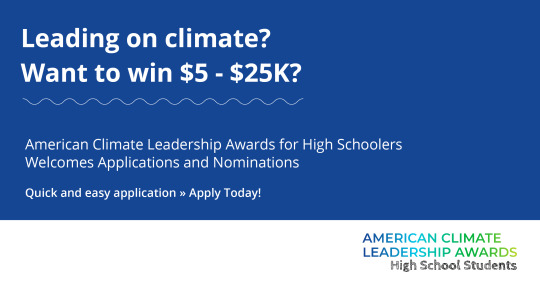
Last call: It's the final week to apply for the American Climate Leadership Awards for High School Students! Apply by Friday, December 15, at midnight PT!
ANNOUNCING: American Climate Leadership Awards has a new category for high school students working towards local climate solutions! @ecoamerica is awarding $125K in cash prizes to student climate leaders. Apply by 12/15: https://ecoamerica.org/american-climate-leadership-awards-high-school-2024/
#ACLA24HighSchoolStudents#ACLA24#high school#high school students#school#education#climate education#environmental education#climate and education#environment and education#climate action#climate and environment#climate#climate and health#climate blog#climate change#climate justice#climate news#weather and climate#environmental news#environment#environmental awareness#environmental activism#environmental justice#environmental#environment protection#environment and health#environmental health
8K notes
·
View notes
Text

List 10 Importance of Geography In the World
#high school#high school students#school#education#climate education#environmental education#climate and education#environment and education#climate action#climate and environment#climate#climate change#climate news#weather and climate#environmental news#environment#environmental awareness#environmental activism#environmental justice#environmental#environment and health#geography#social studies#social science
1 note
·
View note
Text


Enter your information now for a chance to win.
#ACLA24HighSchoolStudents#ACLA24#high school#high school students#school#education#climate education#environmental education#climate and education#environment and education#climate action#climate and environment#climate#climate and health#climate blog#climate change#climate justice#climate news#weather and climate#environmental news#environment#environmental awareness#environmental activism#environmental justice#environmental#environment protection#environment and health#environmental health#shenhe#genshin impact
1 note
·
View note
Text
youtube
#Youtube#ACLA24HighSchoolStudents#ACLA24#high school#high school students#school#education#climate education#environmental education#climate and education#environment and education#climate action
1 note
·
View note
Text
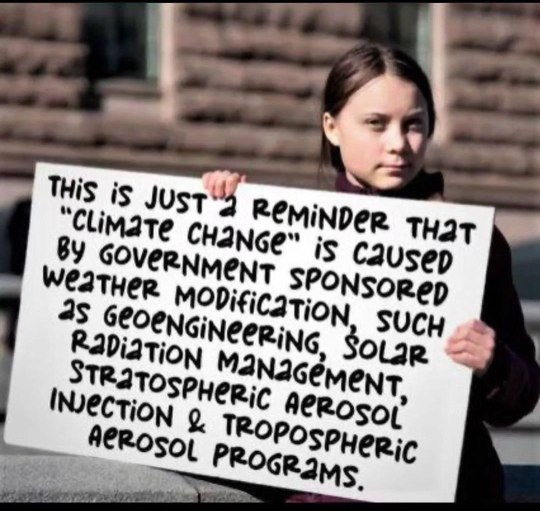
And Lies. 🤔
#pay attention#educate yourselves#educate yourself#knowledge is power#reeducate yourself#reeducate yourselves#think about it#think for yourselves#think for yourself#do your homework#do some research#do your own research#ask yourself questions#question everything#climate change#climate crisis#lies exposed
411 notes
·
View notes
Text
Wild vs. Feral, Domesticated vs. Tame, Native vs. Invasive, and Why Words Matter
Originally posted on my website at https://rebeccalexa.com/wild-vs-feral/
Recently a post crossed my dash on Facebook featuring a small group of llamas in the forests of the Olympic Peninsula. The caption described them as “wild” llamas (Lama glama). That may seem pretty innocuous to the average person, but to a naturalist it’s a gross mischaracterization. For one thing, llamas are completely domestic animals, no more wild than a cow or dog; they are descended from the guanaco (Lama guanacoe), which is a truly wild camelid. So this means that the llamas on the peninsula are feral, not wild. But why does the distinction of wild vs. feral matter so much?
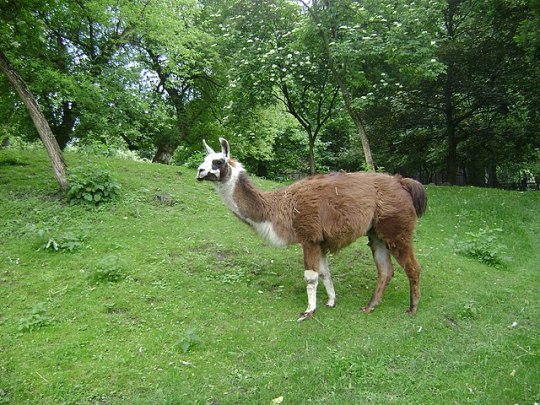
The terms we use to describe various species help us to understand their origin and, perhaps more importantly, their current ecological status. These concepts aren’t just relevant to scientists, however. Everyday people are constantly making decisions that can affect the ecosystems around them, and often these decisions are made without having a full understanding of their impact.
For example, look at how many people release unwanted pets into the wild, whether domesticated rabbits, goldfish, snakes, or other, more exotic animals. Some of these unfortunate animals end up dying pretty awful deaths due to starvation, exposure, or predation. But others manage to survive and reproduce, becoming the latest population of non-native–and potentially invasive–species in their ecosystem. This wouldn’t happen if more people understood the impact of non-native species, and how releasing captive animals puts native species at risk.
But it all starts with knowing that there’s a difference, and understanding the terms that explain why that difference exists. So let’s explore some vocabulary that can be used to describe species, whether animal, plant, or otherwise.
Let’s start with domestication, because there often seems to be confusion as to what makes a species domesticated. Domestication is a process that takes many years, often measured in centuries. Humans breed chosen animals for particular traits over a number of generations. As time passes, each subsequent generation becomes more different from the wild species it originated from, and eventually a new, fully domesticated species emerges from this process of artificial selection by humans.
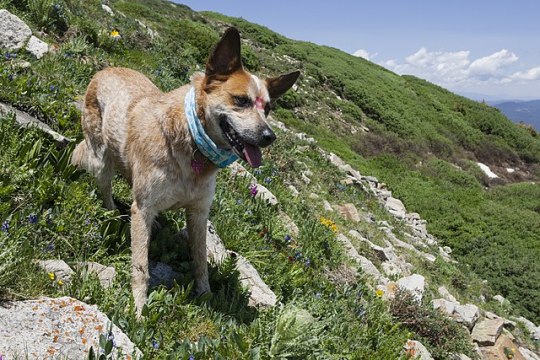
Dogs (Canis familiaris or Canis lupus familiaris) are the first animal humans domesticated in a process that started about 30,000 years ago. They evolved from the now-extinct Pleistocene wolf, a particular lineage of the gray wolf (Canis lupus), and it’s likely that the partnership began as some wolves showed less fear of humans while scavenging from our kills. By 14,000 years ago dogs were a distinct species (or subspecies) from wolves.
Dogs display very different characteristics from wolves. Their faces tend to be shorter with a more pronounced stop (the bump in the forehead where the muzzle meets the rest of the skull.) Floppy ears and curled tails are common, as are patchy-colored coats. Dogs tend to have weaker muscles than wolves of a similar size, shorter legs and smaller feet, smaller teeth, and a smaller size overall. This is a phenomenon known as neoteny, in which domesticated animals have a tendency to retain more juvenile physical traits of their parent wild species, and you can see it in domesticated animals across the board.
But it’s not just physical appearances that matter. Behaviorally dogs are generally more friendly toward humans; in fact, they’ve even developed some human-friendly body language that wolves don’t have, like “puppy dog eyes.” They can be easily trained and, unless poorly socialized, dogs generally enjoy the company of humans.
In many ways, physically and behaviorally, a dog is a wolf that never grew out of its puppy stage. While a young wolf pup may be able to live in someone’s house for a short time, as they grow older they become more destructive and less tolerant of human company. Your dog may love watching out the window during a car ride, but a wolf is going to be much more stressed out by the experience. Even wolf-dog hybrids have to be treated differently than your average domesticated dog because the wolf content has a significant effect on behavior.
This is just one example of how domestication isn’t just a matter of a few generations of selective breeding. You can also compare domesticated horses (Equus ferus caballus) with Przewalski’s horses (Equus ferus przewalskii or Equus przewalskii) or zebras (subgenus Hippotigris), domesticated cows (Bos taurus) with stories of fierce wild aurochs (Bos primigenius), and so forth. In every case the wild and domesticated counterparts are very different in both appearance and behavior.
Now, what about the term “tame”? Many wild animal species have been tamed over the years, either wild-caught individuals or those born in captivity. These tame animals may be more docile in comparison to their fully wild counterparts, but this generally takes a lot of handling and socialization from a young age. Moreover, tame animals retain a lot more wild behaviors than domesticated ones.

Take those supposed “domesticated” foxes that people want to have as pets. Most of the foxes available as pets have no relation to those in the famous Russian fox domestication experiment, but are from modern fur farm lines. And in fact the study foxes came from Russian fur farms, so the researchers were beginning with pre-tamed animals rather than truly wild ones. While some tame foxes may be more amenable to human handling than wild foxes, they are by no means domesticated. They are more prone to wild behaviors like urinating everywhere to mark territory, chewing on anything they can get their jaws on, nipping, and making a LOT of noise. Moreover, whereas dogs adapted to eating an omnivorous diet after millennia of eating alongside us, foxes need a more specialized diet than what you can get at a pet store.
Unfortunately there are unscrupulous people within the exotic pet trade who will advertise their tame (at best) stock as “domesticated.” This often leads consumers to thinking that they’re getting a much more tractable animal that will be as easy to care for as a cat or dog, and sets up everyone involved for disaster (except, of course, the seller with a fatter wallet.)
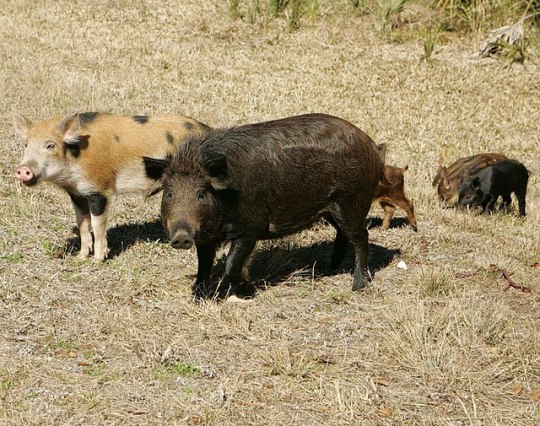
Next, let's compare wild vs. feral. A wild species is one that has never been domesticated, nor have its ancestors. Generally it will be a native species to its ecosystem, though non-native species can also be introduced to an ecosystem without ever having been domesticated. A feral animal, on the other hand, is a member of a domesticated species that has escaped or been released back into the wild and has survived to reproduce new generations that have never been handled by humans.
I’ve often heard people refer to the feral swine (Sus domesticus) that have ravaged ecosystems worldwide as “wild pigs”. They may behave in a wild manner, and they certainly look rougher and hairier than your average well-fed domesticated pig on a farm. It’s not uncommon for feral animals to regain some traits of their wild ancestors. However, that does not make them truly wild.
If you manage to wrest away a litter of newborn piglets from a feral sow and bottle-feed them, they are likely to be able to be socialized and kept in captivity, though they may still physically resemble feral pigs. They haven’t lost the deeply-ingrained genes that carry domesticated traits. However, if you try to raise a newborn Eurasian wild boar (Sus scrofa) or red river hog (Potamochoerus porcus), it will lack the domesticated traits of its farm cousins and show more wild traits as it ages, making it a rather unsuitable pet or farm animal. We also see this return to domestic traits in mustangs and other feral horses captured at a young age. While a mustang born in the wild may be tougher to work with at first than a foal born in captivity and handled from birth, the mustang will be much more calm and easier to train than, say, a zebra.
The problem with referring to feral animals as “wild” is that this suggests they are a natural part of the ecosystem they are in. Because a truly domesticated species (or subspecies) is not the same as the parent species, it has no place to which it is native as a wild animal.

A native species is one that has evolved in a given ecosystem for thousands or even millions of years. In the process it has developed numerous intricate interrelationships with many other species in that ecosystem, creating a careful system of checks and balances. A non-native species is any species that has been taken out of the ecosystem in which it evolved and placed in a different ecosystem where it is not normally found.
For example, here in North America the mourning dove (Zenaida macroura) is a wild native species. While it may resemble domesticated pigeons, it has never been domesticated even when kept in captivity. The Eurasian collared dove (Streptopelia decaocto), on the other hand, was introduced to the Americas after a few dozen individuals were released in the Bahamas in 1974. The feral pigeon (Columba livia domestica) is a domesticated species derived from the rock dove (Columba livia), which is native to Europe, west Asia, and northern Africa. Both the collared dove and pigeon are examples of non-native species. Most non-native species do not offer any benefits to the ecosystems they are introduced to because they do not have established relationships with native species. When they compete with native species for resources, they weaken the ecosystem overall.
Non-native species can be further categorized as naturalized or invasive, or even both. A naturalized species is a non-native one that has managed to establish reproducing populations, rather than going extinct without becoming established. Unfortunately, some people take this to mean that the species has become fully integrated into the new ecosystem. However, this is a process that again takes thousands to millions of years as other species adapt to the newcomer, which itself often also changes as it adapts to its new environment.
Ring-necked pheasants (Phasianus colchicus) are an example of a naturalized species in North America. Native to Asia and parts of Europe, they were introduced here as a game bird 250 years ago. While captive pheasants are regularly released into the wild to offer more hunting opportunities to humans, this species has likely been naturalized from its first introduction.
Again, “naturalized” doesn’t mean “natural”. Pheasants compete with native birds like northern bobwhite (Colinus virginianus) and prairie chickens (Tympanuchus spp.) Not only do they compete for food, nesting sites, and other resources, but they also spread diseases to native birds. Pheasants even engage in brood parasitism, laying their eggs in native birds’ nests and sometimes causing the native birds to abandon the nest and their own young entirely.
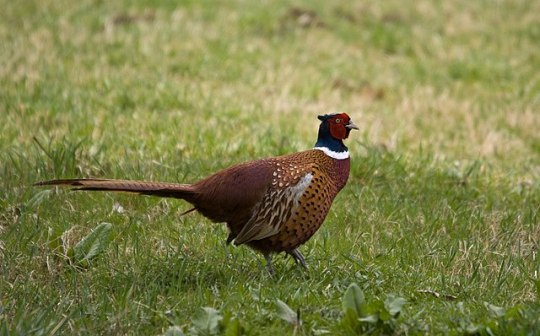
This means that the pheasants are also invasive as well as naturalized. Invasive species are non-natives that aggressively compete with, and sometimes displace or extirpate, native species. There are several hundred species that have become seriously invasive here, including both vertebrate and invertebrate animals, and numerous plants. But even the rest of the over 6000 non-native species that have become naturalized here still put pressure on native species, and have the potential to become invasive if their impact increases to a more damaging point.
Hopefully this gives you a clearer understanding of what these terms mean and why it’s important to know the difference. By knowing a little more about how your local ecosystem works and how different species may be contributing to or detracting from its overall health, you have more power to be able to make decisions that can preserve native species and help ecosystems be more resilient. Given that the removal of invasive species is one of the most important ways we can help ecosystems thrive in spite of climate change, it’s more important than ever that we increase nature literacy among the general populace. Consider this article just one small way to move that effort along.
Did you enjoy this post? Consider taking one of my online foraging and natural history classes or hiring me for a guided nature tour, checking out my other articles, or picking up a paperback or ebook I’ve written! You can even buy me a coffee here!
#wildlife#animals#nature#biology#science#scicomm#invasive species#wild animals#domesticated fox#feral hogs#long post#vocabulary#ecology#educational#biodiversity#conservation#environment#environmentalism#climate change#pigeons
2K notes
·
View notes
Text



hey! as y’all know, Better Future Program is an entirely youth-run nonprofit and we provide over 3,000 FREE social justice, mental health, and academic resources. but because the majority of our volunteers are full-time students in middle school, high school, and college, we need YOUR help!
the screenshotted sections above have WAYYYY less resources than some of the others. do you think you could help us out? if you have leftist, anti-capitalist resources that align with these topics, please submit them here!
to reiterate, we are looking for leftist, anti-capitalist resources pertaining to: Jewish rights, Muslim rights, immigration, climate change, reproductive rights, classism, children’s rights, educational equity, and fat liberation
#reaux speaks#jewish#muslim#migrant rights#immigration#climate change#intersectional environmentalism#antisemitism#islamophobia#reproductive justice#reproductive health#classism#children’s rights#educational equity#fat liberation#fatphobia#body neutrality#resources
484 notes
·
View notes
Text
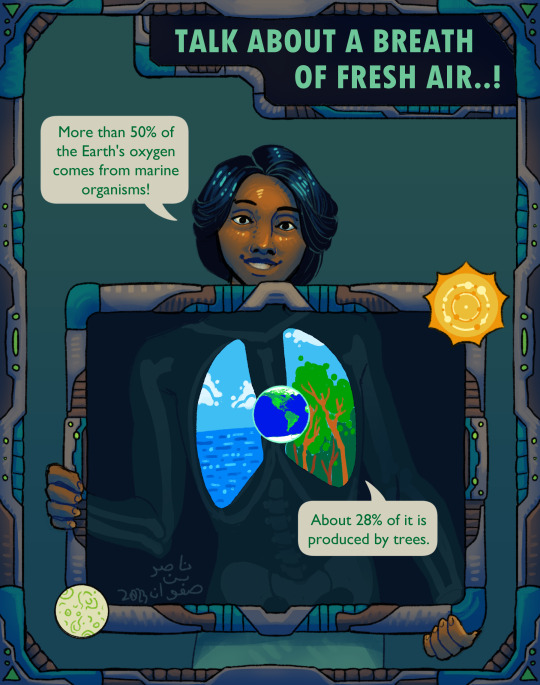
Fun facts about Earth's Atmosphere!
#environmentalism#climate change#environmental science#ecology#conservation#educational poster#void.art
91 notes
·
View notes
Text
Quiet quitting is one of the most bizarre things to me to be discussed in 2022.
It’s mostly bizarre to me, because of the entitlement older generations have towards younger generations and the ignorance they enforce upon my generation, especially in Germany, where I grew up.
You have older generations, usually the generation of my parents, calling us lazy, unable to work well under pressure, etc. I’d like to give insight into the fact that our school system was designed to recreate a work-like state from the age of six. You go to school, learn stuff, go home, do unpaid labor, called “homework”, which has to be good, otherwise you’re labeled as stupid and unable to keep up and have to repeat a year in school. I partially had a workload of 12 hours per day, not because I was poorly structured, but because I had four school subjects per day, with four different kinds of homework which all required at least 30, if not 90 minutes of investment, to do homework properly. Add to that my dyslexia and you get at least 30 minutes more than others. But even non dyslexic students sat there for hours doing homework. I even had my mother do my homework for me, because the work load was too much. Let that sink in.
Then you have a system that rewards pupils who are never sick, by pointing out how there is one kid in class with the most sick days, as though it is their fault that they get sick. Meanwhile you have underpaid and overworked school staff who cannot handle instances of bullying accordingly, resulting in pupils being more sick, especially mentally due to continuous bullying. You create a place that is literally designed to be hostile to human nature, by forcing people to sit still for multiple hours a day, move during breaks to „prevent health problems“ in the future, but give so much homework that hobbies and personal interests can barely be done, and usually if one performs bad at school they have to quit their hobbies because they need to focus more on school or they have their parents cancel their hobbies for them (if they could afford a hobby to begin with), resulting in more stress, because of less possibilities to destress. Then you have heavy school bags that literally fuck up people‘s backs for life, because they have to carry like 10-20kgs of books and folders per day (this was my reality, I kid you not). Then we had no proper food at our cafeteria (for the first four years we had no cafeteria at all, but had to go to school until 3 or 4pm, with no proper food).
Then you have weird power dynamics with teachers who bully you and abuse their power and give you bad grades, just because they think a person with dyslexia should not get the chance to go to university, thereby giving them bad grades, by not answering any of their questions during exams (also something that happened to me and other students as well). And if it’s not dyslexia there is another aspect that a teacher will hate about you and mock you for and treat you like you’re less than a human being than others.
Then we entered a school system that was changed by graduating one year earlier to go to university sooner in Germany, but the school books were not ready for that so we had to carry two books per subject at times, because the subjects we discussed required two books of two school grades. We had no coherent teachings and had to read a lot of stuff at home, by our selves, because the curriculum to teach us properly was not yet developed. And we were asked to understand it all and there was never time for any questions.
Then we finish with a degree, have terrible payments, cannot afford a reasonable lifestyle and are forced to suck it up. Then we have shortages in almost every area, a pandemic we went through a financial crisis, a war that effects the economy and destabilizes a lot in other countries, we have a climate crisis which no politican seems to take seriously enough to do proper change, basically my generaiton in Germany will not have any rent and no positive prospects for the future. Far right extremism seems to be on the rise world wide.
I had my first burn-out in fourth grade and had to go to therapy, because school life was so tough and nobody did anything. I had a parent at home who created immense pressure and guilt if I failed, who regularly assaulted me verbally.
And now our “generation is just lazy”? That shoe just doesn’t fit.
#2022#quiet quitting#capitalism#anti capitalism#school#childhood trauma#school life#growing up#exhausting#Stress#personal#education#school system#gen z#gen y#Future#climate crisis#pandemic#economic crisis
387 notes
·
View notes
Text

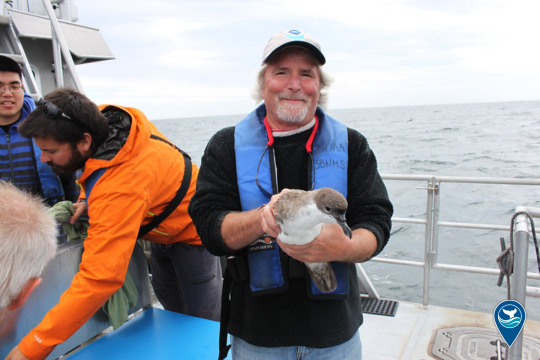


Solving the climate crisis is going to take all of us working together, how can you support climate monitoring at your local sanctuary?
Join us next week to learn about the importance of monitoring climate change impacts in sanctuaries, and how all kinds of visitors - from divers, to teachers, to fishers - are helping to monitor and educate about climate change impacts in NOAA's Stellwagen Bank National Marine Sanctuary and NOAA Florida Keys National Marine Sanctuary.
57 notes
·
View notes
Text
youtube
Watch the 2024 American Climate Leadership Awards for High School Students now: https://youtu.be/5C-bb9PoRLc
The recording is now available on ecoAmerica's YouTube channel for viewers to be inspired by student climate leaders! Join Aishah-Nyeta Brown & Jerome Foster II and be inspired by student climate leaders as we recognize the High School Student finalists. Watch now to find out which student received the $25,000 grand prize and top recognition!
#ACLA24#ACLA24HighSchoolStudents#youtube#youtube video#climate leaders#climate solutions#climate action#climate and environment#climate#climate change#climate and health#climate blog#climate justice#climate news#weather and climate#environmental news#environment#environmental awareness#environment and health#environmental#environmental issues#environmental education#environmental justice#environmental protection#environmental health#high school students#high school#youth#youth of america#school
20K notes
·
View notes
Text
So Much Wasted Human Brilliance
Feeling so pissed off about how we just let so many people's amazing potential go to waste cause they were born in poverty. Literally! we are letting so much human brilliance go to waste for nothing. Human brilliance that could serve the greater good of nature and humanity in ways that would probably have avoided getting us in the majority of messes we are in now!
Human potential, talent, brilliance and genius does NOT discriminate!! neither should we! A good idea is a good idea, a genius invention is a genius invention, a life saving treatment is a life saving treatment regardless of who created it!
It does not serve the world or humanity to let people rot in poverty just cause they're a different colour or speak a different language etc. We could have cured cancer by now probably, if women and poc had been allowed full access to all levels of education from the start. Education should always be free and accessible to all!
And don't give that shit with scholarships, we all know they're bullshit and don't address the deeper root of the problem which is capitalism
#solarpunk#hopepunk#hopecore#peaceful revolution#greenhorizon#anti capitalism#climate change solutions#naturecore#forestcore#lunarpunk#education#civil rights#women's rights#activism#anti fascism#anti racism#intersectionality
15 notes
·
View notes
Text
Any Marxist-Leninist girlies/enbies here? I would like to create a safe space for us to discuss our ideas openly, since I don't see a lot of women with voices in this community :)
Let's share ideas and be friends!!!
💖🏳️🌈
#studyblr#study blog#marxist leninist#socialism#communism#human rights#learning#women in politics#revolution#anti colonialism#anti capitalism#safe space#climate change#study#society#society critical#education#anti imperialism#anti zionisim#karl marx#lets be friends#america#estados unidos#looking for friends#open minded#politics#international law#woke#lesbianism#community
12 notes
·
View notes
Text
Challenges and Solutions in Deforestation in the US
The United States of America, known for its geographical diversity and vast expanses of natural landscapes, finds itself at the center of a significant environmental challenge: deforestation. Often overshadowed by global debates about tropical forest loss, deforestation in the United States is a critical issue that warrants renewed attention. In this article, we will explore the complex reality of deforestation in this country, examining its causes, consequences, and innovative solutions being developed to preserve the valuable forests of the United States. From the vast forests of the Pacific Northwest to the woodlands of the Appalachians, the challenge of deforestation in the United States transcends geographical borders and calls upon us to take meaningful action to safeguard our natural resources and the future of our planet.
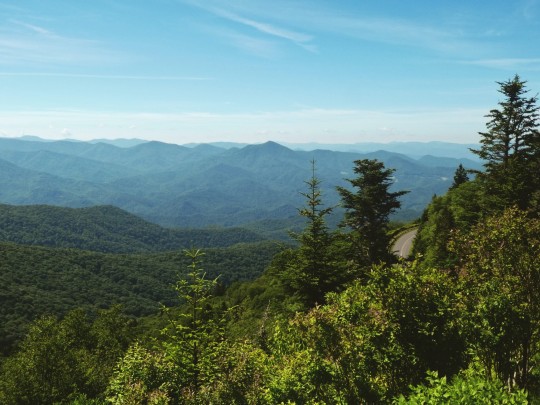
Current Situation of Deforestation in the US
Deforestation in the United States has been a cause for concern for decades. Despite vast forested areas in the country, there is constant pressure on these ecosystems. Below are some key aspects of the current situation of deforestation in the United States:
Loss of Natural Habitat: One of the most noticeable effects of deforestation in the United States is the loss of natural habitat for wildlife. As forests are cleared for urban expansion, agriculture, and industry, many animal and plant species are threatened or displaced.
Climate Change: Forests play a crucial role in carbon capture and climate regulation. Deforestation contributes to climate change by releasing large amounts of carbon stored in trees and forest soil.
Water Quality Effects: Forest clearing can affect the quality of water in nearby rivers and streams. Trees play an important role in filtering contaminants and stabilizing water flow.
Loss of Natural Resources: Deforestation also results in the loss of important natural resources, such as timber. Without sustainable management, forest exploitation can deplete these resources irreversibly.
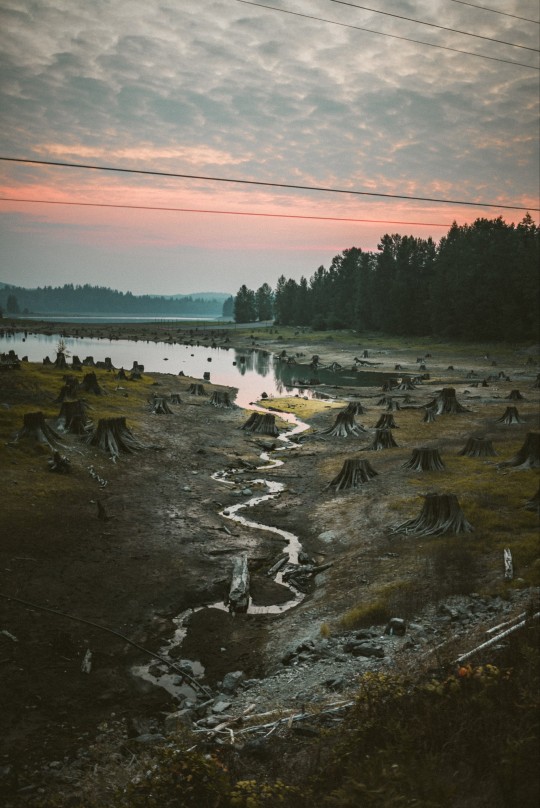
Proposals to Address Deforestation
Given the importance of forests in global health and people's quality of life, it is crucial to take action to address deforestation in the United States. Below are some proposals to tackle this problem:
Promote Sustainable Forestry: Promoting sustainable forest management is essential to ensure that U.S. forests are not overexploited. This involves implementing responsible logging practices that allow for forest regeneration and biodiversity conservation.
Ecosystem Restoration: Investing in the restoration of degraded ecosystems can help reclaim areas that have been deforested in the past. This includes planting native trees and restoring natural habitats.
Protection of Sensitive Areas: Identifying and protecting ecologically valuable areas is crucial. Creating natural reserves and national parks contributes to the conservation of intact ecosystems and biodiversity preservation.
Education and Awareness: Public education about the importance of forests and the impacts of deforestation can encourage informed decision-making and citizen involvement in forest conservation.
Effective Policies and Regulations: Strengthening and enforcing laws and regulations related to tree felling is essential. This includes implementing measures to prevent illegal logging and ensure the sustainability of forest exploitation.
Economic Incentives: Providing economic incentives to businesses and landowners who adopt sustainable forestry practices can be an effective strategy to reduce deforestation.

Conclusion
Deforestation in the United States is a problem that requires ongoing attention and decisive action. Forest loss not only has local impacts but also affects the globe by contributing to climate change and biodiversity loss. To protect our natural resources and ensure a sustainable future, it is essential to effectively address this challenge through sustainable forest management, ecosystem restoration, and public awareness. Only through a comprehensive and collaborative approach can we preserve the valuable forests of the United States for future generations.
Thanks for reading!
-WildTrail team
#deforestation#forest#climate change#pollution#awareness#conciousness#education#nature blog#nature lover#nature#new post#text post#text#reading#read#natural resources#follow#txt post#txt#share#article#social issues#social
42 notes
·
View notes
Text
"If you control the food, you control the people. That's ultimately the end goal."
All around the world, unelected globalist bodies like the WEF and UN are waging war against farmers, in an attempt to seize control of the global food supply, under the banner of UN Agenda 2030—as detailed in a must-watch new documentary titled 'No Farmers, No Food: Will You Eat The Bugs?' 🤔
#pay attention#educate yourselves#educate yourself#knowledge is power#reeducate yourself#reeducate yourselves#think about it#think for yourselves#think for yourself#do your homework#do some research#do your own research#ask yourself questions#question everything#climate crisis#climate change#totalitarianism#socialism#government corruption#food supply#food shortages
524 notes
·
View notes
Text

Can't wait for The Everyday Naturalist to be published next year? I have plenty of reading material for you right now! All of these chapbooks I wrote are available for just $6 each for paperbacks, or $3 for ebooks, at https://rebeccalexa.com/chapbooks/
#birds#birding#foraging#mushrooms#mushroom hunting#invasive species#habitat restoration#pollinators#animals#wildlife#climate change#global warming#ecopsychology#environment#environmentalism#conservation#nature#scicomm#ecology#educational
27 notes
·
View notes